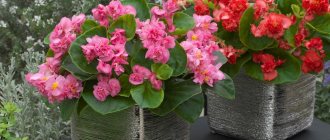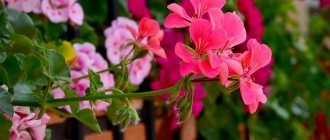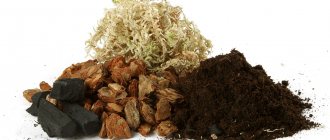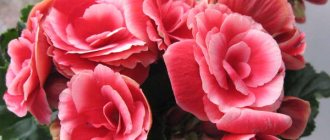Ornamental physalis is an original plant with bright orange fruit calyxes. Outwardly, they resemble Chinese rice paper lanterns. This is an unpretentious plant that is successfully used in landscape design. Thanks to the ease of care, growing physalis in your garden is not at all difficult.
Physalis - a bright decoration of the garden in autumn Source www.bloomingarden.ru
Features of the plant
Physalis is a herbaceous, fairly tall (up to 90 cm) plant with straight stems and oval, slightly tapering leaves. Among more than a hundred subspecies there are:
- edible;
- decorative, which are not intended for food.
Decorative varieties
The popularity of use in landscape design is associated with the spectacular appearance of orange-red boxes with a diameter of 60 mm with a round fruit inside. There can be up to 15 of these “lanterns” on each branch.
Of all the varieties for decorative purposes, the following varieties are most often planted:
- Physalis francheti;
- Physalis alkekengi and others.
Physalis francheti Source wikimedia.org
Lanterns left on branches for the winter become skeletonized under the influence of weather conditions. A bright berry is visible through numerous gaps in the network of veins. Decorative, spectacular branches can be used not only as a means of garden decoration, but also for interesting compositions of dried flowers, as well as crafts.
Important ! The fruits of ornamental plant varieties should not be eaten - they contain toxic substances.
Skeletonized box Source www.greenmarket.com.ua
Varieties that can be used for food
Edible varieties are divided into 2 groups:
- Vegetable.
- Berry.
Berry varieties of physalis include plants with small fruits:
- Pineapple;
- Strawberry;
- Magician;
- Columbus and others.
The annual vegetable has a good yield and has fairly large fruits - weighing up to 50 grams. The most popular varieties: Moscow early and Korolek.
Physalis vegetable Source semenaorg.ru
Only edible varieties have beneficial properties. They are rich in vitamins, proteins, microelements, carbohydrates and other substances. The berries are used raw and as decoctions for medicinal purposes.
For your information ! Berry varieties are heat-loving, while vegetable varieties are resistant to low temperatures.
Types and varieties of physalis for flower beds
To decorate a flower bed near your home, you should pay attention to such varieties of decorative physalis as:
Physalis peruviana
Lemon balm - growing from seeds in the country
This is a perennial whose herbaceous shoots reach 95-160 cm. The shoots are dotted with pubescent foliage, which is naturally heart-shaped. The length of the serrated leaf plates reaches 6-14 cm, the width is in the range of 5-10 cm. During flowering, flowers open on the plant with yellow petals and spots at the base, painted in a dark purple palette. Gradually, berries form in place of the physalis flowers. Thin yellow-brown bracts hide the fruits, whose diameter is 12-18 mm. Sweet and sour berries are endowed with an amazing fruity aroma.
Among the best varieties of Peruvian physalis are:
- pineapple - a variety whose berries ripen at the end of summer, they are endowed with a pronounced pineapple aroma;
- strawberry - a type of perennial, the height of the bushes barely reaches 65 cm. Amber berries exude a strawberry aroma;
- dessert look. Its height reaches 70 cm. There is a small amount of foliage on the bushes, so the bright orange fruits are clearly visible on the plants;
- marmalade variety. The main difference is the presence of branched bushes. Their height can reach 140-150 cm. Physalis berries, which weigh more than 45 g, are colored lilac-yellow.
Physalis vulgaris
It is also a perennial with herbaceous shoots, the height of which is in the range of 45-55 cm. The foliage is ovoid in shape. On each leaf blade you can find swelling between the veins. The width of the foliage is in the range of 5-9 cm, and the length does not exceed 7-12 cm. Physalis flowers, painted in white tones, resemble the shape of a bell. The round berries are hidden under an inflated filmy lantern. Looking at the berries in cross-section, one can note their incredible juiciness.
Note! Eating unripe fruits can lead to poisoning. Edible berries can be used in the preparation of medicinal decoctions.
Physalis decorative
And this is also a perennial crop, the fruits of which, despite their special elegance, are strictly forbidden to eat. Containing toxic substances provoke poisoning and severe vomiting. You can admire the brightly colored lanterns at the end of summer. The most popular variety of decorative physalis is the Franchet variety, whose branched shrubs can reach a height of 85-90 cm. The dark green foliage is naturally endowed with oval outlines. The teardrop-shaped fruits are painted in a scarlet palette.
Choosing a location: how to create the best conditions
Physalis is not picky about where it grows, and can grow even in drafts, and tolerates even low temperatures. Since the decorative value of the plant lies in its lanterns, it is recommended to plant it in sunny areas. The approximate planting density is approximately 5 plants per area of 1 m².
Physalis capsules have not yet gained color Source www.jardin-adoue.com
It is advisable to choose neutral or calcareous soil. Not suitable - too wet acidified soils, as well as with close groundwater.
The soil must be prepared before planting. To do this, they add either complex mineral fertilizers or organic ones (ash, humus, compost).
When choosing a place on a personal plot, you need to take into account what garden crops were grown there before. If in previous years legumes, cabbage, cucumbers, potatoes, beets or carrots grew in the selected place, physalis will also feel good here.
For your information ! The plant cannot be planted in an area that was previously allocated for nightshade crops.
Physalis recipes
Salty
For 1 kg of workpiece:
- Fruits – 1 kg;
- Dill – 50 g;
- Horseradish root - to taste;
- Garlic - 2 cloves;
- Hot pepper - to taste;
- Salt - 50-60 g;
- Currant leaf – 5-7 pcs.;
- Tarragon - a few sprigs;
- Cilantro – 7-10 seeds;
- Water - 1 liter.
Peel, rinse, and place the fruits in sterilized jars. Prepare the brine - boil all the spices and salt in a liter of water. Pour brine over everything and add grated garlic. Leave the jars in a warm place for a week. Check the fermentation process daily. When the brine sours, drain it and boil several times. Pour the contents of the jars with boiling brine, roll up and wrap. Store in a cool place.
Caviar
- Vegetable physalis fruits – 1 kg;
- Onions - 500 g;
- Carrots - 500 g;
- Parsley root - 200 -300 g;
- Salt - to taste;
- Sugar - to taste;
- Garlic – 3 cloves;
- Ground black pepper - 1/2 teaspoon.
Prepare all vegetables and fry in vegetable oil. Place everything in a container, add the rest of the ingredients, and simmer. Grind in a blender, cool. Serve with meat or poultry.
The wonderful plant physalis is not very common, and completely undeservedly. But every lover of beauty, if he dares to plant a wonderful “bubble” of physalis, will definitely be rewarded for his efforts in growing it with the gorgeous glow of Chinese lanterns on cloudy autumn days, the wonderful aroma of exotic jam and spicy, appetite-stimulating pickles.
Rules for caring for ornamental plants
Decorative physalis, the cultivation and care of which is not very difficult, is often used to decorate personal plots. An adult plant is resistant to wind and drought. And it only needs watering when the weather has been dry for a long time. But newly planted physalis requires careful care.
Healthy plant Source plantscientists.com
Decorative physalis needs regular weeding, which should preferably be done at least once a month. This is due to the fact that weeds are able to “clog” the plant, which negatively affects its growth and attractiveness. You can avoid weeding by using mulching. The effect will be greater if the mulch layer is about 20-30 mm.
Fertilizers: when is the best time to apply them?
It is advisable to apply fertilizers twice a year:
- during a period of active growth;
- during the flowering period.
For these purposes, complex mineral fertilizers or humus are used. Another possible problem is the slope of the branches. If you want the stems to remain straight, they should be tied up.
Preparing for winter
The decorative qualities of physalis are the unusualness and originality of its boxes. It is important that they ripen before the onset of autumn cold weather. To do this, at the end of summer it is recommended to pinch the tops of the branches.
All the beauty of physalis Source www.ogorod.ru
For the winter, physalis is left in the ground. In autumn, the stems are cut and later used for home decoration. There is no special shelter for the plant, but it is advisable to mulch the area around it. For this purpose, fallen leaves and peat are used.
Physalis is frost-resistant, withstands frosts down to -30°C. In the spring, in the place where a beautiful bush grew last season, young shoots emerge. Over the course of a season, these “babies” recreate the plant. It can be transplanted to a new place in the spring or left in the same place and admire the bright physalis boxes in early autumn.
For your information ! Even if the above-ground part of the plant is not cut off before the cold weather, it will still die from exposure to low temperatures.
How to “keep” physalis in one place
If there is no need to expand the flower bed with physalis, then for several years (from 5 to 7) it can not be planted. Additionally, to prevent its spread, physalis can be surrounded by a border, or other improvised barriers can be used. In this case, the fence should be buried 0.2-0.3 m so that the roots do not spread to the new territory.
Once established, physalis grows quite quickly on the site. To keep this process under control, it is recommended to rejuvenate it every 5 years: divide the rhizomes and plant them in another place.
For your information ! The decorative quality of a plant directly depends on the quality of care.
The attractiveness of a mono composition Source www.ogorod.ru
Description of culture
Inexperienced flower growers often wonder what physalis is and what it is for. Translated from Greek, “Physalis” means “bubble”.
Where does physalis grow? The territory of South and Central America is considered the birthplace of decorative culture. Gradually, physalis berry gained popularity in North America and Europe.
How does physalis grow?
For your information! French men gave decorative physalis flowers to their wives when they wanted to become a father. A bouquet consisting of bright lanterns was considered a bouquet of pregnant women.
What does physalis look like? The ornamental plant is a representative of the Solanaceae genus. There are more than 100 varieties of physalis. The perennial is unpretentious and can withstand severe winter frosts. The culture can propagate by self-sowing.
The height of the bushes reaches 55-170 cm. How physalis blooms is another question that worries gardeners. During flowering, the physalis plant is dotted with light flowers. At the beginning of autumn, bright orange lanterns appear on the bushes, in which small berries are formed. After a certain period of time, Chinese lanterns lose their rich hue. During this period, only fruits and light veins resembling cobwebs can be seen.
The use of physalis in interior design
Decorative physalis is used in landscape design of the site and as a dried flower. The plant gains decorative value when the lanterns acquire a bright orange-red color. At this stage, you can begin to prepare raw materials for future compositions.
Late autumn Source krrot.net
See also: Catalog of projects for garden houses made of kiln-dried timber
To do this, perform the following steps:
- Cut off the stems.
- Remove leaves.
- Dry for 2-3 weeks in the open air.
It is best to hang dry physalis. If the plant will be used in the form of a finished bouquet, you can tie the stems several pieces together and dry them in this form. If you need separate branches, then each stem must be hung separately.
Bright orange boxes are suitable for interior decoration Source picsart.com
For decoration, you can use not only physalis branches, but also single boxes. Wall wreaths are woven from it and used as part of New Year's compositions along with coniferous branches, craspedia, gomphrena, spikelets and other plants.
New Year's garland decor Source www.ivd.ru
Decorative wreath Source dekormyhome.ru
Composition using physalis Source www.hit-dekor.ru
Useful properties of physalis
Edible physalis berries include a number of substances such as: dietary fiber, carbohydrates, fats, proteins, structured water, vitamins A and C, trace elements iron and zinc and macroelements potassium, calcium, sodium, phosphorus and magnesium. These fruits have a diuretic, hemostatic, choleretic, antimicrobial, analgesic and anti-inflammatory effect. With the help of infusions and decoctions, urolithiasis, edema, gout, bronchitis, rheumatism, hepatitis and cystitis are treated. If you eat fresh fruits, this will improve your health in case of dysentery, dermatosis or hypertension.
Physalis edible and ornamental
The use of physalis in landscape design
Decorative varieties of physalis are used in landscape design in various compositions. From an aesthetic point of view, it is the cups with fruits that are attractive, not the flowers.
Most often, physalis is planted as an independent plant. It must be taken into account that it is better not to plant several varieties in one flower bed, since plants can interbreed. This often affects the decorative qualities of the bushes.
Site design Source rastenievod.com
It is difficult for physalis to find suitable “neighbors”. It is so unusual and bright that it will distract all attention to itself. Even stems with bolls left for the winter will serve as a bright decoration for a snow-covered garden.
Physalis looks good surrounded by low grasses that do not cover it and do not hide all the beauty and originality of the bright boxes with fruits. Very often it is used in containers placed in the garden or installed near the house, as well as in spacious flowerpots.
Growing a plant in a container Source allegroimg.com
The plant is suitable for growing even in those parts of the site that are not suitable for other crops. The green mass of its leaves is a good background for herbaceous, beautifully flowering perennials. But everything changes when the fruit pods on the physalis itself acquire a bright orange color. The main purpose of growing physalis on the site is to obtain material for creating decorative winter compositions in the house.
Important ! When working with a plant, it is necessary to take into account its toxicity.
The boxes gradually acquire an orange color Source lovely-dom.ru
Physalis after flowering
How and when to collect seeds
Physalis fruits are collected together with dried bright cups in dry weather 45-60 days after planting the seedlings in the ground - in August or September. The fruits do not ripen at the same time: the lower berries ripen earlier and fall to the ground. If you pick them right away, you can eat them or send them for processing. Or you can get seeds from them. To do this, ripe fruits are cut in half and filled with rainwater for a day, and then the swollen pulp is rubbed through a sieve, the seeds are washed and dried.
Preparing for winter
The above-ground part of the decorative perennial physalis is cut off in the fall - it will make beautiful dry bouquets. The leaves are removed, and the stems with fruits in bright sheaths are hung to dry. The area is mulched with peat for the winter. Annual (vegetable and berry) species are disposed of after harvesting, and the site is subjected to deep digging.
Diseases and pests: problems and solutions
Physalis is not susceptible to diseases and pest attacks when properly maintained. But this does not mean that a hundred problems will never arise.
Problem #1. Increased soil moisture
If the soil is too wet, rot appears on the stem. The solution to the problem is to transplant the physalis to a place suitable for the plant.
White rot Source rastenievod.com
See also: Catalog of companies that specialize in landscape design
Problem #2. Aphid
There is also a danger of damage to perennials by aphids. This can only happen under the right conditions:
- lack of watering during prolonged drought;
- proximity to plants that are already infected with aphids.
With such damage it is necessary to use insecticides. And as a preventative measure, water as needed.
Problem #3. Late blight
Belonging to the nightshade family, physalis can be affected by late blight. External manifestations are brown spots that appear on fruits and leaves.
As a rule, such a problem occurs due to the following factors:
- thickening;
- long rains.
Late blight Source hozyain.by
The solution to the problem is to act on the warning and prevent its occurrence. To do this, plants should be sprayed even before fruit sets.
Problem #4. Blackleg
External manifestation: blackening of the sprout stem at the base. With such damage, the plant dies.
The following circumstances may lead to this:
- high humidity;
- soil acidification;
- cold air.
To prevent the problem from affecting all seedlings, you must perform the following steps:
- Remove affected shoots from the soil.
- Loosen the soil.
- Treat the soil with fungicides.
Advice ! To prevent this problem from arising, it is necessary to promptly thin out the seedlings and loosen the soil to prevent it from souring.
Black leg completely kills the plant Source dacha.help
Problem #5. Mosaic
Mosaic is a viral disease quite rare for physalis. It is caused by bacterial damage. Externally, the mosaic is manifested by a change in the color of the leaves into dark and light areas.
Ways to solve the problem:
- Remove the plant along with the roots.
- Burn the affected plant.
- The soil in the area where the affected physalis grows must be treated with potassium permanganate.
For your information ! Improper crop rotation can lead to bacterial damage.
Problem #6. Wireworm
The wireworm damages the root system of the plant. This is facilitated by acidification of the soil and the spread of wheatgrass. Adding ash to the soil and controlling weeds will help cope with the problem. This will create an environment unfavorable for the development of wireworm larvae.
Orange wireworm Source zelenj.ru
Problem #7. Medvedka
The danger of a mole cricket attack is damage to the root system. To prevent damage to the plant, you can use the following techniques:
- Throughout the summer, it is necessary to carry out high-quality loosening of 0.15 m.
- Use plants nearby that have a specific aroma and repel mole crickets. Marigolds are suitable for this.
- Watering with a solution of bird droppings has no less effect.
Medvedka spoils the roots Source 7ogorod.ru
Which variety to choose
Seeds of all types of physalis can be bought in specialized stores or ordered online. When choosing, you need to pay attention to the time of fruit ripening. If frosts begin in your region in August, then varieties whose ripening period occurs in September will not be suitable if you plan to grow physalis in open ground.
The color, size and taste of physalis fruits depend on the variety
Table: the most popular varieties of physalis
| Variety name | Appearance, plant height | Fruit ripening period | Size/weight of the fruit, its taste and beneficial properties | Eating, cooking options | Features of the variety |
| Vegetable (Mexican) Physalis | |||||
| Confectioner | The plant is semi-spreading, 60–80 cm high. | Mid-early variety (from germination to the beginning of ripening 116 days), ripening time - August-September. | Fruit weight 60–80 g, smooth yellow fruit. The taste is sweet-sour, astringent. The fruits contain pectin, vitamin C, sugars, mineral salts and trace elements. | The fruits are recommended for pickling and pickling. They make jam from them. | The fruits have an increased shelf life (2–3 months) and, due to their high pectin content, have gelling properties. The plant is resistant to bacterial rot. |
| Marmalade | Up to 1.5 m high, spreading, branched plant. | Mid-season variety (from full germination to the beginning of fruiting 120–130 days), ripening time - July-August. | Fruit weight is 30–40 g, the color of ripe fruits is creamy. Fragrant fruits with plum taste. | The fruits are recommended for fresh consumption, canning, pickling, making jam and preserves. | Shade-tolerant variety. |
| Kinglet | Compact bush 60–80 cm high. | Early ripening variety (from germination to harvest 90–95 days). | Round, dense fruits weighing 60–90 g. The color of the ripe fruit is amber, the taste is sweet and sour. | The fruits are suitable both for fresh consumption and for making caviar, preserves, jams, candied fruits, homemade wine, for pickling and canning. | The variety is characterized by cold resistance and high yield. |
| Jammy | The plant is 1.4–1.6 m high, spreading, branched. | Mid-season variety (from full germination to the beginning of fruiting 110–115 days). | Green fruits weighing 50–60 g have a high gelling ability, anti-inflammatory and analgesic properties. | The fruits are recommended for making preserves, jams, pickles, and marinades. | Shade-tolerant variety. |
| Gourmand | Plant 70–75 cm high. | Early ripening variety. | A yellow, light-colored fruit weighing 120–200 g with a high content of sugars and pectin. | Fruits are recommended for processing. | Drought-resistant, cold-resistant, unpretentious variety. |
| Strawberry (hairy) physalis | |||||
| Raisin (Sugar raisin) | Plant height 80–100 cm. | Early ripening variety, ripening period July-August. | Fragrant and sweet fruits weighing up to 9 g. | The fruits can be used fresh, as well as candied fruits, jams and preserves. | The most shelf-stable variety, the berries in the sepals retain their taste for 6 months. |
| Turkish Delight | Compact, branching plants 30–50 cm high. | Early ripening cold-resistant variety. Fruit ripening occurs on the 90–95th day after germination. | The fruits are round, weighing 6–12 g. The taste is similar to strawberries and pineapple, sweet and sour, juicy and aromatic. | The fruits are suitable for fresh consumption; they are used to make jam, compote, and candied fruits. Dried fruits are used as a substitute for raisins. | The variety is easy to grow, resistant to pests and diseases, including late blight. |
| Gold placer | Compact bushes 30–35 cm high. | Early ripening variety. The fruits ripen on the 92–99th day after germination. | The fruits are round, weighing 4–5 g, juicy, sweet and sour, with the aroma of strawberry and pineapple. | The fruits are suitable for fresh consumption, for making jam and candied fruits. | A productive, long-lasting variety, resistant to diseases and pests. |
| Strawberry | Medium-sized plant up to 70 cm high. | Early ripening variety. | Round, amber-colored fruits weighing 10–15 g. Sweet, with strawberry flavor and aroma. Contain a large amount of pectin, vitamin C, mineral salts and trace elements. | The fruits are consumed fresh and dried, used for making desserts, confectionery, and jam. | A productive variety. |
| Pineapple | Medium height plant. | Early ripening. Fruit ripening occurs on the 105–119th day after full germination. | The fruit is flat-round, the color of the unripe fruit is light green, the color of the ripe fruit is cream. Fruit weight: 50–80 g. | Recommended for fresh consumption, whole-fruit canning, pickling and making preserves and jams. | Shade-tolerant. |
Physalis propagation: all methods
Physalis can be bred in several ways. The simplest, with a high probability of success, is the method of dividing the rhizome, and the most labor-intensive is growing from seeds.
Young sprouts Source rastenievod.com
Growing seedlings from seeds
The start time for work is April. Before sowing seeds, they must be prepared. First, tie it in gauze and dip it in a weak solution of potassium permanganate for half an hour. At the same time, prepare the soil mixture for the seeds.
You can do this in one of the following ways:
- Calcination in the oven.
- Hot steam treatment.
Physalis seeds Source 7dach.ru
After the earth has cooled, it is poured into prepared containers. The following actions are carried out with the seeds:
- Lay out on the surface.
- Pressed.
- Sprinkle 10 mm of soil on top.
- Watered.
- Cover with glass or cling film.
The containers are transferred to a well-lit place, in which the temperature should be maintained at 15-20ºC. After the sprouts have appeared, the glass is removed.
Advice ! Seeds can be planted immediately, if possible, in separate containers with substrate.
After two true leaves appear on the sprouts, a pick is made, mineral fertilizers are applied, and watered. In the future, watering and fertilizing should be regular:
- watering - as needed;
- fertilization - every 2 weeks.
Seeds in a ripe fruit Source lovely-dom.ru
Planting and propagation
In warm regions, physalis can be planted with seeds directly into open ground closer to the beginning of May. The seeds are simply placed in furrows and then thinned out after the seedlings appear. Or you can plant them before winter - in October, but then it is better to mulch the area.
In mid-latitudes, physalis is planted only through seedlings, but it will begin to bear fruit earlier. 1-1.5 months before transplanting into open ground, the seeds are planted in separate pots and left warm until the seedlings appear.
Keep humidity levels low because small sprouts are often susceptible to blackleg. And regularly ventilate the seedlings. If you plant physalis in containers, you can pick it up with the appearance of 2 leaves.
After the formation of 5-6 leaves, physalis can be transplanted into open ground in cloudy weather. It is best to plant bushes in a checkerboard pattern with a distance of at least 0.5 m, because they will branch intensively. The depth of the planting hole is up to the first true leaf.
Photo: 5stihiynn.ru
Composition and calorie content
Physalis has a low calorie content: 100 grams contains only 32 to 55 calories, depending on the type of fruit. Protein and fat contain one gram each, carbohydrates - 3.9 grams, dietary fiber - 1.9 grams, water - 92 grams, ash - 0.55 grams.
- Physalis fruits contain vitamins. The most vitamin C (ascorbic acid) is about 12 mg. Choline (vitamin B4) contains 7.6 mg, vitamin PP - about two mg. There is thiamine (vitamin B1), riboflavin (vitamin B2), pantothenic acid (vitamin B5), pyridoxine (B6), folic acid (vitamin B9), alpha tocopherol (vitamin E), phylloquinone (vitamin K), alpha and beta carotene (provitamin A).
- Of the macroelements in fruits, there are potassium (K) - 268 mg, calcium (Ca) - 7 mg, magnesium (Mg) - 20 mg, sodium (Na) - 1 mg, sulfur (S) - 9.5 mg, phosphorus (Ph ) – 39 mg.
- Microelements in fruits are represented by iron (Fe) - 0.62 mg, manganese (Mn) - 0.15 mg, copper (Cu) - 79 mgk, selenium (Se) - 0.5 mgk, zinc (Zn) - 0.2 mg.
Physalis berries contain lycopene, a carotenoid pigment that determines the color of the berries. Lycopene is a powerful antioxidant and anti-inflammatory agent.
How to dry decorative physalis for a bouquet
After the fruit is finally ripe, the entire upper part of the perennial ornamental variety is cut off, leaving the roots in the ground. The leaves are removed, leaving the stems and cups with fruits, which are hung to dry in a ventilated area without direct sunlight.
If the branches will be used to create compositions with other elements, then they need to be dried separately. If you want to create a bouquet only from physalis fruits, you need to immediately collect them in the desired form, tie them and hang them to dry.
Traditional medicine recipes
To treat various pathologies, the following types of drinks are used: tea, decoction, alcohol tinctures, freshly squeezed juice.
Berry decoction
25 g of dried physalis fruits are poured with boiling water in a volume of 400 ml, the dishes are placed on low heat. Without bringing to a boil, keep covered for 15 minutes. Then remove from the stove, cool and filter. The decoction is taken in a third of a glass 2-3 times a day for diseases of the respiratory tract, kidneys, and stomach pain.
Ointment
To heal cuts, relieve inflammation on the skin, and eliminate joint pain, this composition is made. The berries are finely chopped or crushed in a blender. Add olive oil in a 1:1 ratio and mix well. The mixture is infused in a dark place for three weeks, then the mass is squeezed out and the cake is removed. The ointment is applied to the affected areas 2-3 times a day until the symptoms disappear.
Meaning and application[edit | edit code ]
Decorative types [edit | edit code ]
In Russia, the most widely distributed wild plant is Physalis alkekengi L. - Physalis Alkekengi, or common physalis, or Franchet physalis, or Chinese lantern. This plant overwinters in temperate climates and grows annually from rhizomes. The fruits of this species are unsuitable for consumption due to their bitter taste.
Food species [edit | edit code ]
The fruits of some types of physalis are eaten [4].
In culture in Russia the most common are:
Another type of physalis, Physalis peruviana L. - Peruvian physalis - is grown relatively rarely.
Other species in Russia are grown only by a narrow circle of scientific breeders, botanists and collectors of rare plants.











